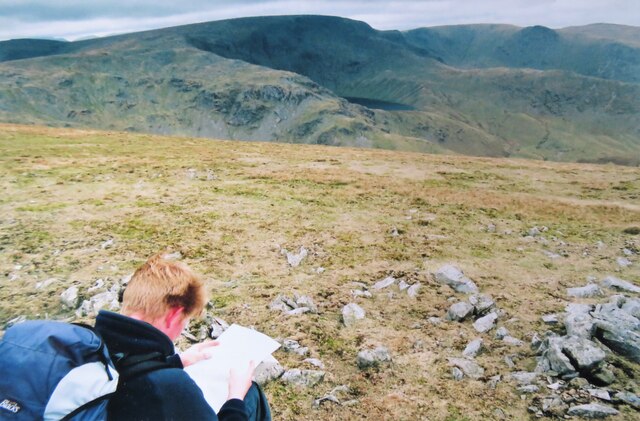Blea Water
Lake, Pool, Pond, Freshwater Marsh in Westmorland Eden
England
Blea Water

Blea Water is a captivating freshwater lake nestled in the picturesque region of Westmorland, located in the northwestern part of England. This stunning body of water is often referred to as a tarn, which is a small mountain lake or pool formed by glacial activity. It is situated in the awe-inspiring Haweswater Reservoir valley, surrounded by the majestic High Street mountain range.
Covering an area of approximately 30 acres, Blea Water is positioned at an elevation of 1,489 feet (454 meters) above sea level, making it the highest tarn in the Lake District National Park. The lake is fed by a combination of rainfall and snowmelt, resulting in crystal-clear, pristine waters that attract nature enthusiasts and photographers alike.
The perimeter of Blea Water is encompassed by a diverse array of vegetation, including heather, grasses, and mosses, which lend a vibrant touch to the surrounding landscape. The lake is also home to a variety of aquatic plants, such as water lilies and pondweeds, which thrive in its nutrient-rich waters.
Due to its remote location and challenging terrain, Blea Water remains relatively untouched, allowing for a tranquil and serene atmosphere. The lake is a haven for wildlife, with numerous species of birds, including golden eagles, peregrine falcons, and red grouse, frequently seen soaring above its waters.
For those seeking outdoor adventures, Blea Water offers opportunities for hiking, with several trails leading to its shores. It is advisable to exercise caution when visiting, as the terrain can be rugged and slippery, especially during inclement weather.
Overall, Blea Water in Westmorland is a hidden gem, providing visitors with a captivating natural setting that showcases the diverse beauty of the Lake District National Park.
If you have any feedback on the listing, please let us know in the comments section below.
Blea Water Images
Images are sourced within 2km of 54.488861/-2.8526027 or Grid Reference NY4410. Thanks to Geograph Open Source API. All images are credited.

![High Streetâs Roman Road Or is it?
The first reference to a Roman Road over the 828m high fell High Street appeared in a book published in 1814 by John Britton and Edward Wedlake Brayley: ‘The Beauties of England and Wales, Or, Delineations, Topographical, Historical, and Descriptive, of Each County’.
In spite of some Victorian excavations, when nothing conclusive was found, the general assumption was that the route connected the Roman forts at Brougham, near Penrith, and Ambleside, suggesting that a likely construction date sometime during the late 1st or early 2nd century A.D.
That assumption is still put forward in many tourist information literature including that of the Lake District National Park.
An archaeological survey in 2006 in advance of some footpath repairs concluded that the road surface “is not what might be described as typical for the Roman period, but it does have some similarities with other [upland] roads of Roman date”.
Lowland Roman Roads were built raised above the general ground level, surfaced with a camber and with ditches either side, to ensure good drainage. In contrast, parts of the route over High Street actually shows signs of being a hollow-way.
So basically no evidence has been found that a road over High Street was built by the Romans. There may well have been an existing prehistoric route which may have been used by the Romans. Maybe even repaired by them.
The photo shows the route of the “road” as it passes the narrow col of the Straits of Riggindale after traversing Rampsgill Head and before the final climb up to High Street.
For sources see my blog <span class="nowrap"><a title="http://www.fhithich.uk/?p=27510" rel="nofollow ugc noopener" href="http://www.fhithich.uk/?p=27510">Link</a><img style="margin-left:2px;" alt="External link" title="External link - shift click to open in new window" src="https://s1.geograph.org.uk/img/external.png" width="10" height="10"/></span>](https://s2.geograph.org.uk/geophotos/07/13/52/7135274_b2865cf0.jpg)
Blea Water is located at Grid Ref: NY4410 (Lat: 54.488861, Lng: -2.8526027)
Administrative County: Cumbria
District: Eden
Police Authority: Cumbria
What 3 Words
///quality.fidgeted.generally. Near Ambleside, Cumbria
Nearby Locations
Related Wikis
Blea Water
Blea Water is a tarn or corrie lake which occupies a glacially excavated hollow immediately to the east of High Street in the Lake District, England. At...
Mardale Ill Bell
Mardale Ill Bell is a fell in the English Lake District, rising to the south west of Haweswater Reservoir. It stands on the watershed between Mardale and...
High Street (Lake District)
High Street is a fell in the English Lake District. At 828 metres (2,717 ft), its summit is the highest point in the far eastern part of the national park...
Thornthwaite Crag
Thornthwaite Crag is a fell in the English Lake District, standing to the west of Haweswater Reservoir. It is a focal point of the Far Eastern Fells, standing...
Harter Fell (Mardale)
Harter Fell is a fell in the far eastern part of the English Lake District. The summit at lies the meeting point of three ridges, and Harter Fell forms...
Kidsty Pike
Kidsty Pike is a fell in the English Lake District, standing to the west of Haweswater Reservoir. It is a subsidiary top of Rampsgill Head, but has long...
Rampsgill Head
Rampsgill Head is a fell in the English Lake District, standing to the west of Haweswater Reservoir in the Far Eastern Fells. It forms the focal point...
Hayeswater
Hayeswater is a small lake within the Lake District of Cumbria, England. The lake is situated about a mile (1.6 km) SE of the hamlet of Hartsop in the...
Nearby Amenities
Located within 500m of 54.488861,-2.8526027Have you been to Blea Water?
Leave your review of Blea Water below (or comments, questions and feedback).


















